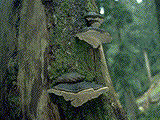Archived Content
Information identified as archived on the Web is for reference, research or recordkeeping purposes. It has not been altered or updated after the date of archiving. Web pages that are archived on the Web are not subject to the Government of Canada Web Standards. As per the Communications Policy of the Government of Canada, you can request alternate formats on the Contact Us page.
Brown Crumbly Rot
Fomitopsis pinicola (Sw.:Fr) P. Karst
(= Fomes pinicola (Sw.:Fr.) Cooke)
Basidiomycotina, Aphyllophorales, Polyporaceae
Hosts:Fomitopsis pinicola commonly occurs on a wide range of hosts in B.C., including: amabilis, grand, and subalpine fir, Engelmann, white, and Sitka spruce, lodgepole, western white, and ponderosa pine, Douglas-fir, western redcedar, western, mountain, and eastern hemlock, western larch, red alder, paper birch, aspen, cottonwood, plum, and peach. Elsewhere in North America it is also reported on black spruce, cypress, incense and yellow cedar, sequoia, apple, ash, basswood, beech, cherry, chestnut, hickory, magnolia, maple, oak, pear, sycamore, and willow.
Distribution: This fungus is widely distributed throughout the range of its hosts in B.C.
Identification: Fruiting bodies are usually found on dead wood but they occasionally develop on living trees in association with wounds or mistletoe infections. They are perennial, leathery to woody, and hoof-shaped or shelved (Figs. 12a, 12b). The upper surface is usually zoned and has a wide range in colour from dark brown through grey to black. The margin is rounded, often red-brown and lighter than other portions of the upper surface. The lower surface is white to cream and poroid; the pores are circular, 5-6 per mm The context is consistently buff with a tough, corky texture. When fruiting bodies are first developing they appear as firm white masses of fungal material on the bark.
The incipient stage of the decay appears as a yellow-brown to brown stain. Later the wood breaks into small cubes which are soft and crumbly in texture, generally lighter in colour than most crumbly brown rots (Fig. 12c). Relatively thick white felts of mycelium may form in the shrinkage cracks.
Microscopic Characteristics: Hyphae in the context of the fruiting body of three types: generative hyphae thin-walled with clamps, skeletal, and tramal hyphae thick-walled without septa. Basidiospores cylindric-ellipsoid, hyaline, smooth, IKI-, 6-9 x 3.5-4.5 µm.
Growth in culture slow to moderate, mat white, laccase negative, clamps. Stalpers: (7) (8) (11) (12) (13) 14 (17) (18) 19 21 22 (24) (25) 30 (31) 39 42 (44) 45 46 (47) (48) (51) 52 53 54 (55) 83 85 (88) (89) (90) (93).
Damage:Fomitopsis pinicola is one the most damaging decay fungi in old-growth forests. It is a less serious problem in second-growth stands but infected dead trees are subject to wind-throw and top-breakage making them high-risk hazard trees.
Remarks: Brown crumbly rot is one of the most frequently occurring decays in B.C. It occurs frequently as a sap rot but can also gain entrance to the heartwood through wounds and cause considerable damage to living trees. The fungus is very common on dead trees and has a very important ecological role in the degradation of woody forest litter.
References:
Etheridge, D. E. 1973. Wound parasites causing tree decay in British Columbia. Can. For. Serv., Forest Pest Leaf. No. 62. Victoria, B.C.
Figures
Click on any image to see the full size version.
Press "Back" on your browser to return to this screen.

Figure 12a: Fruiting bodies of Fomitopsis pinicola.
 Figure 12b: Fruiting bodies of Fomitopsis pinicola.
Figure 12b: Fruiting bodies of Fomitopsis pinicola.
 Figure 12c: Advanced decay of Douglas-fir by F. pinicola. Note brown cubical rot and white mycelium in the cracks of decayed wood.
Figure 12c: Advanced decay of Douglas-fir by F. pinicola. Note brown cubical rot and white mycelium in the cracks of decayed wood.
 This Web page has been archived on the Web.
This Web page has been archived on the Web.